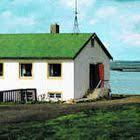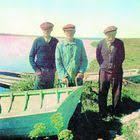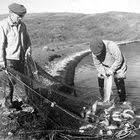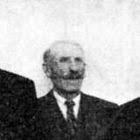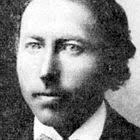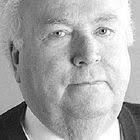Jóabræður
Translated from Icelandic with google translate (mbl.is).
A celestial happiness broke over the face of the Finnish president, says Leifur Sveinsson. He had found what he was looking for.
I
It is December 6, Finland's National Day, and the Finnish Wine Society Suomi celebrates, which shows a film of the President of Finland's visit to Iceland in 1957. As with other heads of state visits, the schedule was quite rigid, but he had the opportunity to vacation for half a day during his visit to the Mývatn area on August 18, 1957. President Kekkonen chose to meet "a typical Icelandic farmer" and his appeal was well received. The escort team took him to Sigfús Hallgrímsson, the farmer and organist in Vogar, and was well welcomed there. Sigfús spoke in both Scandinavian and English, asked if the President would rather hear a quartet, octet or 16-person mixed choir, but Kekkonen denied all of this in the words that this versatile man was the best person in recognition, but this was just no ordinary farmer . They were then held to the Joab brothers on Geiteyjarstrand, but they were already legendary characters alive. They were called Sigurd, Jon and John, either called Jokar or Jóabrödur. They are now notified who is coming to visit and they are asked to say hello to the big man. So they now walk out of their house in the correct age range, Siggi first, Jón then, but Jói last. Siggi walks in front of Kekkonen, shakes his hand in a Myvatn custom, and says, "So you're from Finland, boy." A heavenly smile broke across the face of the Finnish President. He had found what he was looking for. This movie scene was so great that I can't remember anyone else stating it. Hopefully this film still exists, but the film will have been filmed on 16mm film. (Urho Kekkonen 1900-1986, President of Finland 1956-1982.)
II
But who were Jokar and who were my acquaintances of them? Those brothers quickly became my friends during the Mývatn Years 1936-1941. Every spring I provided them with "Mývatnsspænn" and wolf shuttles from the Sporting Goods Store Reykjavik. I always went on a boat with these products, because then I could have my veneer out in the coast of both ways. Did not miss the fact that I put one and one burn in this way. My first summers in the countryside, they lived in the old town, but in 1937 they embarked on building a handsome stone house. Their stepdaughter was named Sigríður Daníelsdóttir (1890-1979), a brave widow, many children. I once came to the old town and found the tunnel quite long and dry about them.
III
One time we went to Thorhallur Hallgrímsson, my master in Vogar, to go fishing south in the Gulf. The weather suddenly deteriorated and I did not think well enough of Thorhall, so he asked Jóka to take me with me to the country but they were about to stop fishing. I crossed into their boat and was already held ashore. Jokar offered me food and that meal is very memorable for me. It was obvious that the dessert had to be dipped with blueberries, because two bowls were already on the table with these elegant refreshments. The main course, which turned out to be a hangover box, was not on the table, so brothers who were hungry by the water picked up their self-esteem and got one and one blueberry by sticking the knife tip into them. Now it was time for the hangout box and we all took good care of our food, but then came to the well with the blueberries. Then it was clear to see who was in the lead in this home, because Siggi, who was the eldest of the brothers, reached up and took a corner veneer from there, one of the best grips. He then ate the cane with the shavings, but the rest of us had to get enough spoons. After a meal, Siggi licked the veneer carefully, then brushed his elbow on his jacket and then put it back on. I have eaten in Versailles at the invitation of the French Foreign Minister and several other great men, but no meal is half-eaten by those I consumed with Jókum in the summer of 1940.
IV
Sigurleifur was a man named Vagnsson (1897-1950), an assistant in the Department of Labor at the University of Iceland. He met me on Geiteyjarstrand around 1939 and he stood there in the yard at Jókar at one work desk, which stood on the trunk. There he slaughtered and aged trout, and it seemed good to me to follow him with this work. His daughter Erna (b. 1922) was with him for a while. Although Jokar was most likely a pure boy, the edge did not rise when they saw this pale eye. Erna later married Arni Ársælsson, a physician (1922-1993), who was a longtime physician at the hospital in Húsavík, but she became an actress herself. I remember her best in the wonderful play "Deep Roots", which was shown in Iðnó 1952. She now lives in Reykjavik.
V
Helgi Þorsteinsson from Skörður in Reykjahverfi bought Geiteyjarströnd in 1784 and his descendants lived in a straight male on earth until the 7th century of the last century, when Jókar stopped farming in the semi-highland, the elderly and childless. Their father's name was Jóhannes Sigurðsson (1855-1934) born on Geiteyjarströnd, but their mother Guðrún Jóhannesdóttir (1852-1931) born on Krákárbakki. They began farming on Geiteyjarströnd in 1880. Their sons: 1) Sigurður Jóhannesson, born March 2, 1881, died March 23, 1966. A builder from Hólar 1907 in the time of Sigurður schoolmaster Sigurðsson from Draflastöðir. 2) Jón Jóhannesson was born on February 12, 1884, died on January 10, 1966. 3) Jóhannes Jóhannesson was born on February 21, 1888, died on January 25, 1969. After the death of Gudrun, their mother, in 1931, for a while the council of the fathers Sigrún Sigurjónsdóttir (1885-1983), sister of Fjalla-Bensa. Thus, the land is described in "Settlements and Estates" 1963: "The land is rather small. The land is mostly rocky and lava. The grassland is along the water, but there is a large forest in the eastern part of the country. There are Dimmuborgs, the vast lava fields, which J travels. at Háey in Mývatn and two good laying islands, Krókhólmur and Landhólmur. The land was for a long time the largest hunting ground at Mývatn, while there were no restrictions on reindeer fishing, and hot springs were often hunted during the summer in the land. There are still good facilities for fishing. Many have wondered that the earth is called Geiteyjarstrand, but not Geitey on Lake Mývatn. That explanation has long lived among Mývetninga, that a widow had lived on Geiteyjarstrand earlier in the centuries and sent after the Reykjahlíð Priest to give him the last sacrament. The priest makes her petition and was alone with her when she took the last sigh. Then comes out of a widow's room and is asked about the well-being: "She did not partake well, gave the Reykjahlíð church Geitey just before she parted." Then came a saying, which is still heard in the Mývatnssveit: "She still gives, the whole."
On April 4, 1876, Skútustaðir was made a priest's center and from 1880 is called the priestly call Skútustaðapråkall.
VI
In an interview that Gísli Sigurdsson, then editor of the Week, had with Jóka on September 13, 1962, says, among other things. about those brothers: "These were childish and sincere, old men. They said goodbye to me, and thanked me very much for the visit." This was at the age of 74, 79 and 81. In a memo, I am writing about my friend Stefán Jónasson (1919-2000) August 31 last year in Mbl. states, inter alia: "Early in the war years, the brothers Stebbi and Nóni decide to go to Reykjavík for a job search, because there had been enough work but little work for them in Vogar. because they were the only people in the countryside who had the money, they carried the errand and said they needed a ferry to Reykjavik. Siggi on the Strand, who had all the leadership in hand for those Jokabrethren, "went to the old box" and took out the notes, who asked, but added, "Don't you need more? Jokes were no match, unforgettable to all who met them." Jokes kept their money mainly in boxes because they had bad experience of storing them in books, e.g. deposit book in Kaupfélag Thingeyinga, but lost most of its deposit, is K.þ. crashed once more often. Hólmfríður Pétursdóttir in Víðihlíð in the Mývatnssveit has looked after the memory of his uncle, Jóka, among others. by setting up a hundred-year-old web site Sigga á Strönd in the Myvatn Museum in Skútustöðir. There she was assisted by Oddný Magnúsdóttir in Húsavík. Hólmfríður has also kept a record of Sigurd's diaries, and it will be interesting to read the history of this unique home, when historians have worked out these sources.
VII
I loved the Joka brothers, they treated all guests with as much sincerity and leadership, whether as a boy from a neighboring town in Vogar, or the president of Finland. Their mission in this earthly life was to become a neighbor of theirs, but not much favored by banknotes in the ancient coffin. These were, of course, special people, legendary characters in living life, but they made a great impression on the Myvatn quarry in the first half of the last century and the memory of them will live long, for where good men go, there are God's ways.
